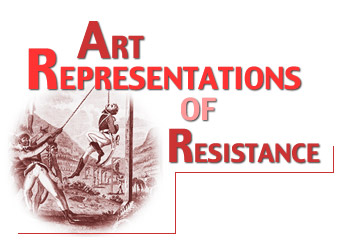Many have described art as the guardian of our culture, a compass into our collective past, an avenue leading us to the attitude and ideals of people who lived centuries ago. This eloquent rhetoric creates a romantic idea of the creative process, yet one must question the validity of such statements. How can we evaluate the thought and reasoning of a great master when in actuality we have little to go on, but our own judgment and the stolid theory of classical art theorists? The context within which the art was painted, and the context in which it is now judged seem unrelated. The agenda of the contemporary viewer and the artist are similarly distanced. Yet, the evaluation of art as a historical source becomes a valid method of histographical examination.
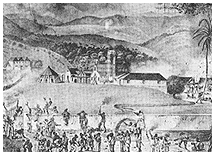 There are several key methods and ideas behind this assertion. Firstly, art has to be understood within the context in which it was created. No matter how subtle, art contains elements of political, cultural, sociological influence and this in turn becomes a factor in interpretation. For instance, Rainsford's illustrations in his An Historical Account of the Black Empire of Haiti, require some understanding of the relationship between the British and French and their roles in the Haitian Revolution. However, this assumes that art cannot stand alone, and provide its own meaning and view on history. What is important is the criteria or motive for the work; to understand why an artist has chosen to portray the subject in such a manner. There are several key methods and ideas behind this assertion. Firstly, art has to be understood within the context in which it was created. No matter how subtle, art contains elements of political, cultural, sociological influence and this in turn becomes a factor in interpretation. For instance, Rainsford's illustrations in his An Historical Account of the Black Empire of Haiti, require some understanding of the relationship between the British and French and their roles in the Haitian Revolution. However, this assumes that art cannot stand alone, and provide its own meaning and view on history. What is important is the criteria or motive for the work; to understand why an artist has chosen to portray the subject in such a manner.
Moreover, art, when interpreted under historical auspices, requires secondary evidence. Such is the case with William Blake. Through his romanticization of the slave figure to the idea of the noble savage, Blake illustrates his opposition to slavery. This interpretation, however, is in part based on the text of and conversations with Gabriel Stedman. Both the book itself, Narrative of a Five Year Expedition, and records of the period show that Stedman and Blake had formed a friendship (through the exchange of presents and meetings) and that Stedman become Blake’s primary link to the slave owning world. This influence ensures that Blake’s illustrations can be read with his anti-slavery attitude in mind.
Perhaps, then, art simply illustrates how certain power interests wanted to represent the world, and not what really happened. This in many ways is true, for centuries art was the privilege of those who had power, and thus artists became bound by the commission, only able to paint or reflect the views of their patrons. But, art opens views on society unimagined by, and to some extent uncontrolled by, the mighty and powerful. For instance, the portrayal of slaves as savages served to promote the acceptance of slavery among British society - yet, it also tells us about the importance of slavery within the colonial economic system and the lengths that plantation owners were prepared to go to protect and preserve this system. And in the end, art acted to dramatize and even praise the resistance of enslaved Africans.
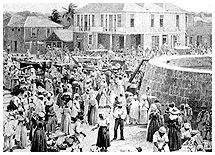 Undoubtedly, art does not contain the information found in established records, like parish registers for instance. However, art, on a very basic level, is able to tell us how people lived. In one visual image of a plantation, the artist is giving the viewer an idea of what people wore, what their daily activities were, and how they lived. Essentially, art gives the audience an emotional connection to a historical event in a way that records and registers cannot. Undoubtedly, art does not contain the information found in established records, like parish registers for instance. However, art, on a very basic level, is able to tell us how people lived. In one visual image of a plantation, the artist is giving the viewer an idea of what people wore, what their daily activities were, and how they lived. Essentially, art gives the audience an emotional connection to a historical event in a way that records and registers cannot.
The idea of art as a historical source forms the basis of investigation for our two essays. However, while both papers examine different aspects of art within the slavery years of the English and French colonies, we also sought to understand how important art became within the context of resistance. Essay one seeks to understand the establishment of the world’s first Black Republic, Haiti, and how this act of ultimate resistance was interpreted by those artists of the time. The role of bias and influence becomes vitally important in understanding what message the artists were trying to convey: whether they were supportive of the revolution and why. The second essay look to understand the English attitude towards slavery, and to investigate whether there was any opposition to this institution and how was this opposition manifested. Both the artists examined are not classical abolitionists. They have not chosen to show their resistance to slavery through the classical images of a kneeling slave begging for freedom. Instead, Blake has sought to bring the slaves a humanistic touch - his portrayal of slaves in Surinam is similar to his portrayal of angelic or religious figures in his later works. In contrast, Hogarth’s resistance comes not so much from a common concern for his fellow man but rather from his distaste of the products of slavery as manifested within English society. He uses slaves to show the corrupt and corrupting force of wealth derived from sugar and tobacco, during the Augustan era.
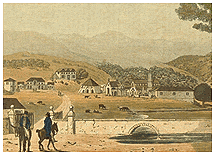 The resistance shown within the art of Blake, Rainsford, Hogarth and others marks a watershed moment in the art world. This era was the first time that artists were able to sell directly to the public through the increase of newspapers and cheap books; rather than the patron-commission system. Thus, the degree of expression, and even the subject matter was gradually undergoing a metamorphosis where by art became a personal manifestation. As a result of this, the art of resistance became a far more viable concept. Artists were now able to register their displeasure with colonialism, slavery and other current themes and issues. The resistance shown within the art of Blake, Rainsford, Hogarth and others marks a watershed moment in the art world. This era was the first time that artists were able to sell directly to the public through the increase of newspapers and cheap books; rather than the patron-commission system. Thus, the degree of expression, and even the subject matter was gradually undergoing a metamorphosis where by art became a personal manifestation. As a result of this, the art of resistance became a far more viable concept. Artists were now able to register their displeasure with colonialism, slavery and other current themes and issues.
Interestingly, while resistance in art was a process developing in the ‘Western’ world, there is very little indication that a similar process was happening in the colonies. Early art produced by or for white colonists does not seek to demonstrate resistance, perhaps due its close proximity to the institutions it would normally seek to demonize and the underlying economic and social reliance upon these institutions. And very little art produced by slaves survives. However, while paintings and sculptures remain elusive, slave resistance is manifested through dance, song and religion, which have managed to survive.
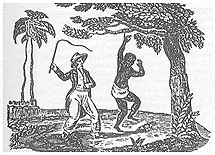 Through the 18th century, the abolitionists and pro-slavery camps battled out their ideological differences through art. Pamphlets containing art sought to educate the masses as to the pros or cons of slavery. However, once the declaration of emancipation was issued, depictions of blacks took on a different form. They ceased to be the focus of so much rhetoric and instead were now openly depicted in a racist manner - as lazy, ape like creatures. For as essay one discusses, it is one thing to advocate the end of slavery yet quite another to accept former slaves as equals. This idea continued through to the early 20th century; but then black artists depicting blacks sought to counter years of racists imagery. The view of equality became less important as black artists sought to interpret their ethnicity differently from they ways in which they had been depicted by whites. Through the 18th century, the abolitionists and pro-slavery camps battled out their ideological differences through art. Pamphlets containing art sought to educate the masses as to the pros or cons of slavery. However, once the declaration of emancipation was issued, depictions of blacks took on a different form. They ceased to be the focus of so much rhetoric and instead were now openly depicted in a racist manner - as lazy, ape like creatures. For as essay one discusses, it is one thing to advocate the end of slavery yet quite another to accept former slaves as equals. This idea continued through to the early 20th century; but then black artists depicting blacks sought to counter years of racists imagery. The view of equality became less important as black artists sought to interpret their ethnicity differently from they ways in which they had been depicted by whites.
The ideas and themes employed in art during the colonial period can give us a clear idea of the social, cultural and political traditions surrounding slavery and slaves. More specifically, illustrations, having become a tool of understanding for the illiterate masses, thus provide a wider cultural record. When used in conjunction with texts and records, the historian is able to match the attitude expressed in the parliamentary record with the creative process: allowing each to balance and complement each other, and to finally provide the widest view possible of the subject.
|



